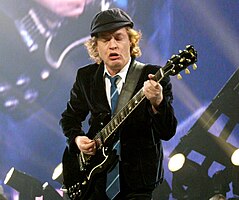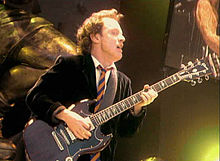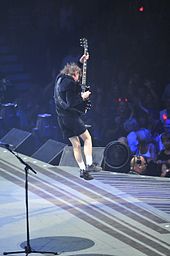| Revision as of 23:16, 26 March 2021 edit85.255.236.59 (talk) →GuitarsTags: Mobile edit Mobile web edit← Previous edit | Revision as of 14:06, 31 March 2021 edit undo2601:989:4002:b880:b198:8612:c2d3:f5b8 (talk)No edit summaryTags: possible birth or death date change Reverted Mobile edit Mobile web editNext edit → | ||
| Line 9: | Line 9: | ||
| | caption = Young performing in November 2008 | | caption = Young performing in November 2008 | ||
| | birth_name = Angus McKinnon Young | | birth_name = Angus McKinnon Young | ||
| | birth_date = {{birth date and age|df= |
| birth_date = {{birth date and age|df=66|1955|3|31}} | ||
| | birth_place = ], Scotland | | birth_place = ], Scotland | ||
| | instrument = Guitar | | instrument = Guitar | ||
Revision as of 14:06, 31 March 2021
Australian guitarist For the actor born Angus Young, see Alan Young.
| Angus Young | |
|---|---|
 Young performing in November 2008 Young performing in November 2008 | |
| Background information | |
| Birth name | Angus McKinnon Young |
| Born | (1955-03-31) 31 March 1955 (age 69) Glasgow, Scotland |
| Genres | Hard rock, blues rock, rock and roll |
| Occupations |
|
| Instrument | Guitar |
| Years active | 1970–present |
| Labels | EMI, Epic, Atlantic, Albert, Columbia |
| Website | acdc |
Angus McKinnon Young (born 31 March 1955) is an Australian musician, best known as the co-founder, lead guitarist, and songwriter of the Australian hard rock band AC/DC. He is known for his energetic performances, schoolboy-uniform stage outfits and his own version of Chuck Berry's duckwalk. Young was ranked 24th in Rolling Stone magazine's 100 greatest guitarists of all-time list. In 2003, Young and the other members of AC/DC were inducted into the Rock and Roll Hall of Fame.
Early life
Young's father, William Young (born 16 February 1911) and his family lived at 6 Skerryvore Road in the Cranhill district of Glasgow in Scotland. William worked first as a wheel boy in a rope works and then as a machine / saw operator in an asbestos / cement business. In 1940 William joined the Royal Air Force serving in World War II as a flight engine mechanic. After the war William worked as a yard man for a builder and then as a postman. His wife Margaret (born 14 July 1913; maiden name also Young) was a housewife.
The Big Freeze of 1963 was the worst winter on record in Scotland with snow eight feet deep. A TV advertisement at the same time offered assisted travel for families for a different life in Australia. Fifteen members of the Young family left Scotland by aeroplane in late June 1963 including fifth son, George (6 November 1946 – 22 October 2017), and younger brothers, Malcolm (6 January 1953 – 18 November 2017) and Angus (born 31 March 1955). Also aboard were his eldest brother Stephen (24 June 1933 – 1989), his only sister, Margaret Horsburgh (2 May 1935 – 11 November 2019) and brother, William Jr (born 15 December 1940). Another elder brother, Alex (28 December 1938 – 1997), who was a member of Tony Sheridan's backup group The Bobby Patrick Big Six, stayed in Europe and was later a member of London-based group, Grapefruit. A final brother, John Young (born 17 May 1937), had migrated to Australia separately. Malcolm later described the family's musical background, "All the males in our family played, Stevie, the oldest played accordion, Alex and John were the first couple to play guitar, and being older it was sort of passed down to George, then myself, then Angus." His oldest brother Stevie was the father of Stevie Young who in later years took over from Malcolm in AC/DC.
Initially staying at Villawood Migrant Hostel (a site later developed as Villawood Immigration Detention Centre) in Nissen huts, George Young met and became friends with another migrant, Harry Vanda. The Young family moved into a semi detached house at 4 Burleigh Street in the Sydney suburb of Burwood. Young dropped out of Ashfield Boys High School at age 15. Young first started playing on a banjo, re-strung with six strings. He first started playing guitar on a cheap acoustic model purchased second-hand by his mother. His first Gibson SG was bought second-hand around 1970 from a music shop just down the street from his home: "I got out and got a Gibson SG that I played until it got wood rot because so much sweat and water got into it. The whole neck warped. I bought it second-hand; it was about a '67. It had a real thin neck, really slim, like a Custom neck. It was dark brown."
Career

Both Angus and Malcolm Young were in a band with their brother George and his music partner Harry Vanda called Marcus Hook Roll Band. The project released an album in Australia called Tales of Old Grand Daddy.
Prior to forming AC/DC, Angus Young played in a local group called Kantuckee. Kantuckee's line-up included Bob McGlynn (vocals), Angus Young (guitar), Jon Stevens (bass), and Trevor James (drums). The band split and was later called Tantrum with the following line up: Mark Sneddon (vocals-guitar), Angus Young (guitar), Jon Stevens (bass) and Trevor James (drums).
Young was 18 when he and older brother Malcolm formed AC/DC in 1973. Angus was on lead guitar, Malcolm on rhythm guitar, Colin Burgess on drums, Larry Van Kriedt on bass guitar and Dave Evans on vocals. "Can I Sit Next To You Girl," their first single, was later re-recorded with Bon Scott as their vocalist. They decided upon the name AC/DC, suggested by their sister Margaret, who saw the letters "AC/DC" on the back of her sewing machine.
Young tried a number of stage costumes, such as Spider-Man, Zorro, a gorilla, and a parody of Superman, named Super-Ang, before settling on his signature schoolboy look at the suggestion of his sister. To match this image the press and public were told that Young was born in 1959, not 1955. The original uniform was created by his sister Margaret and when it fell apart from wear and tear, he used his uniform from Ashfield Boys High School in Sydney.
AC/DC released their debut album, High Voltage, on 17 February 1975. Over the next three years AC/DC cemented themselves as a popular hard rock act, especially in Australia, with the follow-up albums, T.N.T., Dirty Deeds Done Dirt Cheap, Let There Be Rock and Powerage. All their albums until this point were produced by Young's brother George in partnership with Harry Vanda. Their 1979 studio album, Highway to Hell, became their best-selling at the time and launched them to new heights of fame.
Months after this, Scott died from alcohol poisoning. Questions were raised as to whether the band could continue without him. Young and his other bandmates soon decided they should finish the work they had begun for their new album, so they recruited ex-Geordie singer Brian Johnson to replace Scott. Five months later, Back in Black was released as a tribute to Scott. It quickly became a huge success, far outselling any of their previous albums, and going on to reach 22x multi-platinum in the US alone, and selling 50 million copies, the second highest-selling album worldwide, behind only Michael Jackson's Thriller. AC/DC's next album, For Those About to Rock We Salute You, cemented their position as the most popular hard rock act of the time.
AC/DC's popularity declined with their next three albums, Flick of the Switch, Fly on the Wall and Blow Up Your Video. AC/DC looked as though they had reached their peak early in the 1980s and by the end of the decade were in decline. Malcolm Young missed the majority of the band's 1988 Blow Up Your Video World Tour to address his drinking problem. He eventually became sober and returned to the band. During his absence he was replaced by his nephew, Stevie Young.
The band's 1990 studio album, The Razors Edge, brought them back into the spotlight, reaching 5x multi-platinum in the US alone and selling between 10 and 12 million copies worldwide. Over the next 10 years AC/DC released two other studio albums, Ballbreaker and Stiff Upper Lip, which confirmed their renewed popularity and success. After a lengthy eight-year hiatus, AC/DC returned with a new studio album, Black Ice. Black Ice debuted at number 1 in 29 countries and was certified multi-platinum in 14 of those, becoming one of their most successful albums worldwide, and was followed by a hugely successful world tour. In 2010, AC/DC released an album of songs used for the Iron Man 2 soundtrack they had put together; this reached number one in many countries around the world, including the UK, and number four in the US. Malcolm Young confirmed in 2011 that AC/DC were working on a 16th studio album.
In April 2014 Malcolm Young was forced to leave the band due to ill health, leaving Angus the sole continuous founding member left in the band. In May it was revealed that Stevie Young, Malcolm and Angus's nephew, would stand in for his uncle to record AC/DC's latest record. In September Malcolm officially retired and Stevie was made AC/DC's official full-time rhythm guitarist. AC/DC released Rock or Bust in the fall of 2014. In March 2016, after the departure of both Malcolm Young and drummer Phil Rudd, AC/DC was set back with yet another departure; long time lead singer Brian Johnson was ordered by doctors to stop performing or face total hearing loss. Angus, determined to finish what the band started, recruited Guns N' Roses singer Axl Rose to stand in for Johnson for the remainder of the Rock or Bust World Tour. On September 30, 2020, the band's official Twitter account announced the pending release of a new album, Power Up, with the lineup of Angus Young, Stevie Young, Brian Johnson, Cliff Williams and Phil Rudd.
In 2003, AC/DC were inducted into the Rock and Roll hall of fame and the following year they were ranked number 72 on Rolling Stone magazine's list of the "100 greatest artists of all time." VH1 ranked them number 23 on their list of the "100 greatest artists of all time" and number 4 in their list of the "100 greatest artists of hard rock."
Personal life
Young is married to a Dutch woman named Ellen van Lochem. They own homes in Australia, the UK, and the Netherlands.
Although a heavy smoker, Young is a teetotaler and has been all his life. He is a supporter of Rangers F.C.
On 24 August 2006, Young received Kerrang! magazine's Legend Award from the editor, Paul Brannigan, who called AC/DC "one of the most important and influential rock bands in history". On 16 May 2012, he was named the "Best Australian Guitarist of All Time" in a poll conducted by Australian Guitar Magazine.
Equipment
Guitars

Young has used Gibson SGs in various forms (his original, and the basis for his current signature model, was a 1969 - 1971 SG Standard) throughout his career. He also used a modified version of the SG called the Jaydee SG, which was made custom for Young by Jaydee guitars. At least two of his SGs (whether modified Gibson product or ground-up construction) circa 1977 and the Paris "Let There Be Rock" tapings featured on-board wireless going to his amplifiers, the circuitry installed in a cavity routed into the back of the body. This practice was discontinued due to the potential for electrical shorts due to sweat, and at least one of these guitars would be repaired and used for the Rock or Bust tour. The Jaydee SG featured signature lightning bolt inlays on the fretboard. Gibson made a custom SG for Young with lightning bolt inlays to replace the Jaydee SG. Young's '69 - '71 SG has T Top humbucking pick-ups. Another 1964 SG that he used on the recording of Ballbreaker, has patent # pick-ups. All of these are vintage-output Alnico II or V pick-ups with matched coils typically reading 7.5k - 7.8k DCR. Beginning in 2009, Young started fitting Seymour Duncan humbuckers to all of his touring guitars. He uses Ernie Ball Super Slinky guitar strings (.009-.042) and Fender "Extra Heavy" picks.
Angus Young SG
Young and Gibson Guitar Corporation have collaborated to make the Angus Young SG. It features a pick-up designed by Young himself (the Angus Young Signature Humbucker) in the bridge position, and a '57 Classic Humbucker in the neck. The neck has "lightning bolt" inlays.
Amplifiers
Young mainly uses Marshall 1959 100 watt Super Lead Plexi heads and model 1960 AX and BX 4x12 cabinets with Celestion G12-65 speakers. Later amplifiers included Marshall JMP 2203 and most recently, Wizard Amplifiers. Early wireless systems, the Schaffer-Vega Diversity System that he would begin using in 1977, was also used as a compressor and a booster in his signal to "fatten up" his tone. Ever since adding it to his rig, it was used on several albums in the studio for chosen rhythm guitar tracks and all lead guitar tracks. Beginning with Rock or Bust, due to the discontinuation of the Schaffer system, Young began using a replica of the unit's preamp with a commercial wireless unit from Shure.
Influence
Young has stated that he first began playing guitar when he was "little, teeny. I would sort of dabble around five or six years old. That's when I started hearing Little Richard."
In an interview with The Guitar Show, Young noted his influences include his brother Malcolm Young, Chuck Berry, Freddie King, and Muddy Waters, while playing licks relating to Jimi Hendrix, Pete Townshend, John Lee Hooker, and The Kinks' "You Really Got Me".
Young has indicated that he was also influenced by Keith Richards, as well as Chuck Berry's performing style, including his banter with audiences and duck walk. When the band covered Chuck Berry songs in their early years, audiences would recognise the song, while noting their renditions were very different from the source material.
Style

Young's playing style is influenced by straight blues playing in both the minor and major pentatonic twelve bar blues-type progressions. In AC/DC's earlier recordings, power chords can be heard in songs such as "T.N.T." and "It's a Long Way to the Top (If You Wanna Rock 'n' Roll)". He also utilises touches of Scottish folk in his playing, and pull-off arpeggios (pull-offs played one-handed) are a popular trick, appearing in songs such as "Who Made Who", "Dirty Deeds Done Dirt Cheap", "Sin City", and live renditions of "Let There Be Rock". In 1976, the band recorded an instrumental arrangement of the Scottish traditional song "Loch Lomond", retitled "Fling Thing", which has appeared in their stage act over the years. The title refers to the Highland Fling. Young occasionally provides backing vocals along with Malcolm on songs such as "T.N.T." and "Dirty Deeds Done Dirt Cheap".

A common criticism of AC/DC is that their songs are excessively simple and formulaic. In reply, Young stated in an interview with the Atlanta Gazette in 1979: "It's just rock and roll. A lot of times we get criticised for it. A lot of music papers come out with: 'When are they going to stop playing these three chords?' If you believe you shouldn't play just three chords it's pretty silly on their part. To us, the simpler a song is, the better, 'cause it's more in line with what the person on the street is."
Young is famous for his wild onstage antics, such as intense jumps and running back and forth across the stage. Once, he would clamber onto Bon Scott's or Brian Johnson's shoulders during concerts and they would make their way through the audience with smoke streaming from a satchel on Young's back, while he played an extended improvised guitar solo, usually during the song "Rocker" with Scott or "Let There Be Rock" with Johnson. He frequently does his own version of Chuck Berry's duck walk, as well as a "spasm" during which he throws himself to the ground, kicking, shaking, and spinning in circles while playing the guitar.
Young was advised by older brother George that, if he ever tripped over his guitar cable, to keep playing and make it look like part of the act. Young also included a sort of striptease as part of a mid-show ritual, during which he slowly took off his schoolboy outfit, running across the stage to elicit cheers from the audience, culminating in a "mooning" gesture to expose his underwear, generally chosen with the colours of the local flag or occasionally offering a brief glimpse of his bare buttocks. He would then grab his guitar and play the remainder of the show topless. According to AC/DC video director David Mallet, although Young performs many of his trademark feats sometimes from a series of platforms, risers, and ramps, he suffers from a fear of heights; this was discovered when Mallet chose to have Young lowered from a second story balcony onto a stage floor by wires for the video for "Who Made Who".
Discography
Marcus Hook Roll Band
- Tales of Old Grand Daddy (1973 Australia, 1978 America, 2014 international)
AC/DC
Main article: AC/DC discography- High Voltage (1975, Australia only)
- T.N.T. (1975, Australia only)
- High Voltage (1976, International version)
- Dirty Deeds Done Dirt Cheap (1976)
- Let There Be Rock (1977)
- Powerage (1978)
- If You Want Blood You've Got It (1978)
- Highway to Hell (1979)
- Back in Black (1980)
- For Those About to Rock We Salute You (1981)
- Flick of the Switch (1983)
- Fly on the Wall (1985)
- Who Made Who (1986)
- Blow Up Your Video (1988)
- The Razors Edge (1990)
- Ballbreaker (1995)
- Stiff Upper Lip (2000)
- Black Ice (2008)
- Rock or Bust (2014)
- Power Up (2020)
References
- "100 Greatest Guitarists: Angus Young". Rolling Stone. Retrieved 7 May 2012.
- ^ "Item details for: A1877, May 1963 Young W". National Archive of Australia. 13 February 2009. Retrieved 23 October 2017.
- ^ "Easy Beats to AC/DC, The Story of Aussie Rock". BBC TV. Retrieved 4 November 2017.
- "Biography for Angus Young". IMDb, UK. Retrieved 7 February 2013.
- "Biography – Angus Young". allaxess. Archived from the original on 15 March 2013. Retrieved 7 February 2013.
- ^ Tait, John Francis; ProQuest (2010), Vanda & Young: Inside Australia's Hit Factory, University of New South Wales Press, ISBN 978-1-74223-217-1
- Nick Warburton. "The Bobby Patrick Big Six". Retrieved 7 March 2021.
- ^ Wall, Mick (2012). AC/DC: Hell Aint a Bad Place to Be. London: Orion Publishing group. ISBN 9781409115359.
- "AC/DC's ANGUS YOUNG Says STEVIE YOUNG Was 'The Logical Choice' To Step in For MALCOLM YOUNG". BLABBERMOUTH.NET. 24 November 2014. Retrieved 7 October 2016.
- "The Young House, 4 Burleigh Street, Burwood". Issuu.
- ^ Hall, Russell (26 July 2011). "10 Things You Might Not Know About AC/DC's Angus Young". Gibson. Archived from the original on 19 April 2012. Retrieved 4 August 2011.
Young left school before his 15th birthday.
- Archived 13 August 2006 at the Wayback Machine
- Baker, Glenn A. (14 March 1981). "Vanda and Young: AC/DC and the Young Brothers". Billboard. 93 (10): VY-4, VY-11.
- Engleheart, Murray; Durieux, Arnaud (2006). AC/DC Maximum Rock & Roll: The Ultimate Story of the World's Greatest Rock and Roll Band. pp. 50–51. ISBN 978-0-06-113391-6.
- Walker, Clinton (2001). Highway to Hell: The Life and Times of AC/DC Legend Bon Scott. pp. 128–133. ISBN 1-891241-13-3.
- Hudson, Fiona (4 February 2007). "AC/DC star's mega-mansion". The Sunday Telegraph.
- "Malcolm Young at Ibrox". Rangers.co.uk. Retrieved 21 May 2010.
- Brown, Mark (25 August 2006). "Lostprophets on their metal as they top the Kerrang! awards". The Guardian. London. Retrieved 25 April 2010.
- "Best 50 Australian Guitar Players of all time | Australian Guitar Magazine". Australianguitarmag.com.au. 15 May 2012. Retrieved 25 July 2014.
- "Angus Young AC/DC jaydee SG guitar". Jaydeeguitars.com. Retrieved 25 March 2010.
- ^ "Rig Rundown:AC/DC". Premier Guitar. Retrieved 25 October 2017.
- "Seymour Duncan helps Angus Young with his tone". Seymour Duncan.
- "Ernie Ball RPS-9". Ernieball.com. Retrieved 2 June 2011.
- "Pick Power – Angus Young Guitar Pick – Brand and Gauge". KillerGuitarRigs.com. Retrieved 5 August 2020.
- "Angus Young Signature SG". Gibson.com. 24 June 2008. Retrieved 2 June 2011.
- "Did Angus use any effects? – Page 2". Marshallforum.com. Retrieved 7 May 2012.
- ^ "Angus Young". Acdcwillie.tripod.com. Archived from the original on 17 July 2011. Retrieved 2 June 2011.
- "YouTube". YouTube. Retrieved 25 July 2014.
- "YouTube". YouTube. Retrieved 25 July 2014.
- ^ The Guitar Show television documentary, Segment: "Upfront with AC/DC's Angus Young", 2001.
- "Photo". Nolifetilmetal.com. Retrieved 25 July 2014.
- "Young on Johnson's shoulders photo". I283.photobucket.com. Retrieved 25 July 2014.
- "Angus Young Duck Walk Photo". I283.photobucket.com. Retrieved 25 July 2014.
- "Angus Young Spasm Photo". I283.photobucket.com. Retrieved 25 July 2014.
- Interview: Hard as a Rock (video)
External links
| Rock and Roll Hall of Fame – Class of 2003 | |
|---|---|
| Performers | |
| Non-performers (Ahmet Ertegun Award) | |
| Sidemen | |
- 1955 births
- Australian people of Scottish descent
- Living people
- AC/DC members
- APRA Award winners
- Australian blues guitarists
- Australian multi-instrumentalists
- Australian rock guitarists
- Kerrang! Awards winners
- Lead guitarists
- Australian male guitarists
- Naturalised citizens of Australia
- People from Cranhill
- Musicians from Sydney
- Musicians from Glasgow
- People from the Sutherland Shire
- Scottish emigrants to Australia
- Young musical family (Scotland/Australia)
- Australian expatriates in the Netherlands
- People educated at Ashfield Boys' High School